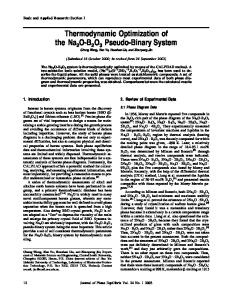Thermodynamic Evaluation and Optimization of the MnO-B 2 O 3 and MnO-B 2 O 3 -SiO 2 Systems and Its Application to Oxida
- PDF / 730,296 Bytes
- 12 Pages / 593.972 x 792 pts Page_size
- 34 Downloads / 310 Views
ODUCTION
BORON is a useful micro-alloying element in steels because of its significant effect on hardenability enhancement. Recently, several studies focused on the oxide formation affected by micro-alloying elements such as P, B, Sn, Sb, etc.,[1,2] and revealed that the oxidation of B is faster than other elements in the steel matrix, and also B can be depleted in the depth of 50-100 lm from the surface by boron oxide formation in annealing process. Typically, the addition of B below 10 weight ppm would be recommended in utilizing B for advanced high-strength steels (AHSS) because too much B in steel can result in poor surface quality and bare spots in galvanizing process.[3] However, AHSS containing small amount of boron can have a possibility to form the MnO-B2O3-SiO2 oxide layer in association with oxidations of Mn and Si in annealing furnace, which can change Zn galvanizing property. Despite the importance of the MnO-B2O3-SiO2 oxide system, the phase diagrams and thermodynamic properties of the oxide system have been poorly investigated. The purpose of this study is to perform a complete literature review, critical evaluation, and thermodynamic optimization of phase diagram and thermodynamic properties of all oxide phases in the MnO-B2O3 and YOUNG-MIN KIM, Senior Researcher, is with the Advanced Welding and Joining R&BD Group, Korea Institute of Industrial Technology (KITECH), Gaetbeol-ro 156, Yeonsu-Gu, Incheon 406840, Korea. IN-HO JUNG, Associate Professor, is with the Department of Mining and Materials Engineering, McGill University, 3610 University Street, Montreal, QC H3A 0C5, Canada. Contact e-mail: [email protected] Manuscript submitted December 31, 2012. Article published online March 18, 2015 2736—VOLUME 46A, JUNE 2015
MnO-B2O3-SiO2 systems at 1 bar pressure to calculate the oxidation behavior of AHSS containing B. The molten oxide phase was described by the Modified Quasichemical Model. In particular, as there are limited experimental data available for the MnO-B2O3-SiO2 system, the systematic analysis of the similar systems like CaO-B2O3-SiO2 and MgO-B2O3-SiO2 was performed to reasonably estimate the Gibbs energy of solid and liquid phases of the MnO-B2O3-SiO2 system. Because the oxidation of AHSS happens at reduced partial pressure of oxygen condition, only divalent Mn oxide (MnO) was considered in the present study.
II.
THERMODYNAMIC MODELS
In the thermodynamic ‘optimization (modeling)’ of a chemical system, all available thermodynamic and phase equilibrium data are evaluated simultaneously in order to obtain one set of model equations for the Gibbs energies of all phases as functions of temperature and composition. From these equations, all thermodynamic properties and the phase diagrams can be back-calculated. In this way, all the data are rendered selfconsistent and consistent with thermodynamic principles. Thermodynamic property data, such as activity data, can aid in the evaluation of the phase diagram, and phase diagram measurements can be used to deduce thermodynamic properties. Discrepan
Data Loading...











